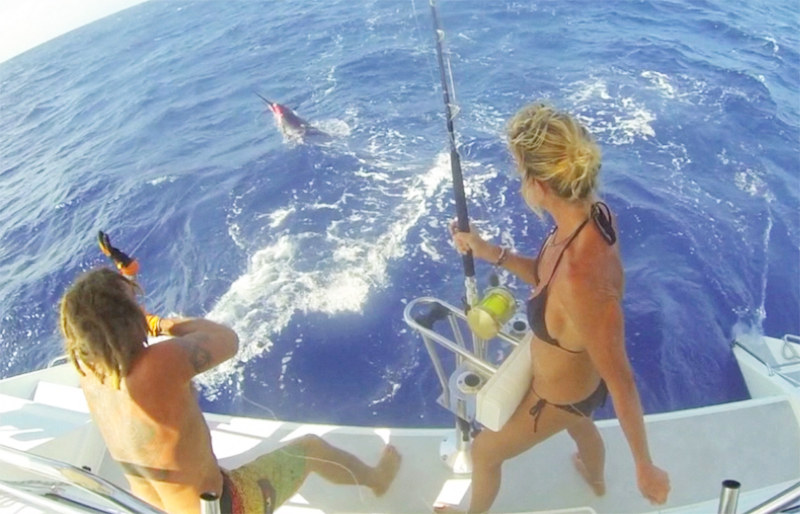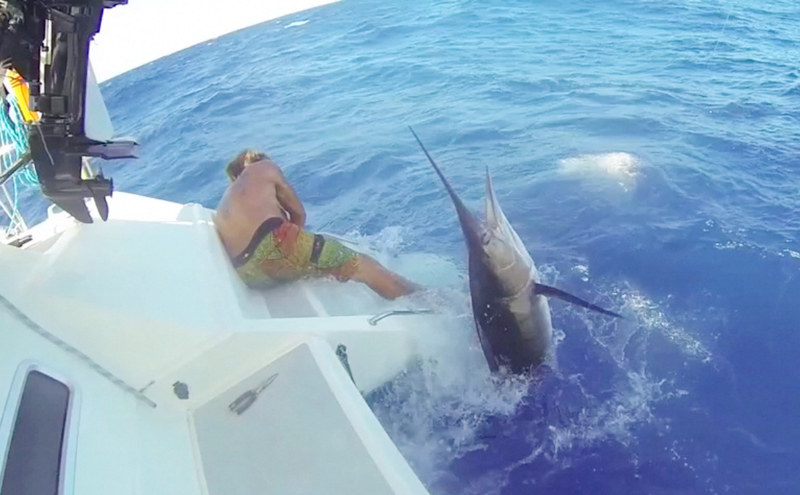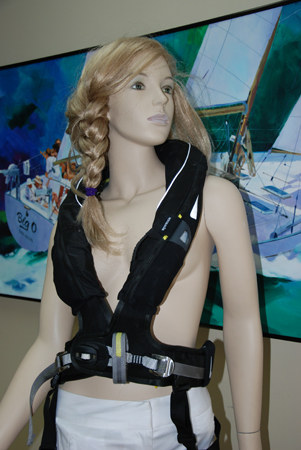
Sportfishing While Puddle Jumping

How do sailors pass the time during the 3,000-mile passage to French Polynesia? Some read lots of novels, some do boat projects, some research the islands they are soon to visit, and some catch up on all the sleep they missed in the frantic weeks before departing. But aboard the Montana-based St. Francis 44 catamaran Skabenga the focus is usually on game fishing.
Crew Jennifer Martindale sets the scene: "We are under spinnaker and main doing 10 knots in 18 knots of wind." Nevertheless, the crew has a "full spread" of fishing gear out, meaning five lines off the stern of the boat, four in rod holders and one in the fighting station on the transom, with the two outer lines held by huge outriggers. The prize they are seeking is big dorado or marlin.
All of a sudden the crew hears an unmistakable sound: Whhhrrrr! Something big is on one of the lines. Captain Bruce runs to the spinning line and sets the drag, then yells, “Fynn and Jen, reel in all the other lines!” Next, they drop the main and Fynn, Bruce’s 19-year-old son, kicks on the engines and directs the boat to the best angle and speed to retrieve the fish: “Twenty degrees to port, 20 more to port, more throttle, neutral!” yells Bruce.
"I am directing the GoPro on the transom to get footage while holding the fishing rod with the fish on it," explains Jen, "so Bruce can go down on the swim step to bring the fish in by hand. I get my first glimpse of the fish: a beautiful blue marlin that Bruce estimates to be between 350 and 400 pounds.
"He is close to the boat now, but not without a fight. On the swim step Bruce is pulling the line in hand over hand to land the fish. I’m going through mental-man overboard drills while holding on to the rod and filming. Bruce and the fish are duking it out as he tries to bring it on board before letting it go. The fish disappears under the starboard rudder and starts circling underneath the boat. . . Bruce has his back turned, looking over the side of the swim step, when all of the sudden I see the marlin come around the other side straight out of the water with his bill pointed at Bruce. ‘Bruce! Behind you!’ I yell, as the marlin slaps the swim step inches from him. Just then, I feel the line of the rod I am holding slacken, and I know the fish has gotten off."

So up go the main and spinnaker again, and out go the rest of the lines. All in a day’s work aboard Skabenga, whose captain sells a whole line of custom-made lures. Jen has crossed the Pacific before, but not on a boat whose motto is ‘Catching marlin under sail.’ "What a beautiful fish and what an exciting ride!" says Jen.
What Would Redford Do?
After buying my first keelboat many years ago, I picked up a little book that gave an overview of all the issues boaters should be concerned with. Chapter one was called Keeping the Water Out. I couldn’t help thinking about that cleverly simplistic title a few weeks ago while watching the highly acclaimed Robert Redford film All is Lost.
Apparently Redford’s character had never read that little boater’s guide, because when he awoke from a nap and discovered his sloop had been holed at the waterline, he walked right past the gaping hole on his way to the cockpit without making the slightest effort to slow the inflow of water. And while he did take steps later to patch the hole, he waited until the entire cabin was flooded before switching on his bilge pumps and thinking to put out a pan-pan via radio. (He was supposedly in the middle if the Indian Ocean.)

©2014 Latitude 38 Media, LLC
The sequence of actions Redford’s character performed left us screaming advice at the video screen. So we posed the question to ‘Lec Lat readers: In order, what five things would you do first? We got a flood of thoughtful responses. Jack Oldrin and many others thought as I did about step one: "Plug the hole!!!!!!!" Karl Wilber’s first response would be to "immediately change tacks to lift impacted area above waterline." (Redford’s character eventually did that.) Richard Byhre said, first, "Start the engine and get pumps running."
But safety expert Chuck Hawley would take other initial steps: 1) Ensure that the life raft is able to be launched (not compromised by the damage caused by the collision, on deck, tether attached). 2) Ensure that the ditch bag is attached to the raft or at least nearby, not in a quarter berth or inaccessible locker. 3) Attempt to broadcast a mayday. If unable, turn on EPIRB. 4) Attempt to stem the flow of water, either by getting the hole farther out of the water, or by cramming stuff into the hole from the inside, or by putting a collision mat on it from the outside. 5) Alternate between dewatering the boat and patching the hole.
If you haven’t seen the flick, we warn you that it might drive you crazy with frustration, as the sole character’s actions exhibit something less than brilliant seamanship. Still, it may be a worthwhile exercise, as it certainly forces you to confront the very real possibility of being holed by a shipping container in mid-ocean someday, and consider what first steps you would take on your own vessel — so your story won’t end as badly as Redford’s did.
Life Jacket Inspections/Exchange
The California State Parks Division of Boating and Waterways is hosting a lifejacket trade-in program statewide this coming Saturday, May 17 from noon to 2 p.m. Families are encouraged to bring their lifejackets to any of the 46 statewide locations to have them professionally inspected. If a lifejacket is found to be outgrown or unserviceable, a new fitted lifejacket will be provided free in exchange for the old one. One exchange per family will be offered while supplies last.

©2014 Latitude 38 Media, LLC
This program takes place in conjunction with National Safe Boating Week (May 17-23), which aims to educate the public about lifejacket safety and other life-saving boating practices. Local inspection locations include Alameda, Clear Lake, Angel Island (Tiburon) and Mill Valley. To find an inspection site near you, click here.
